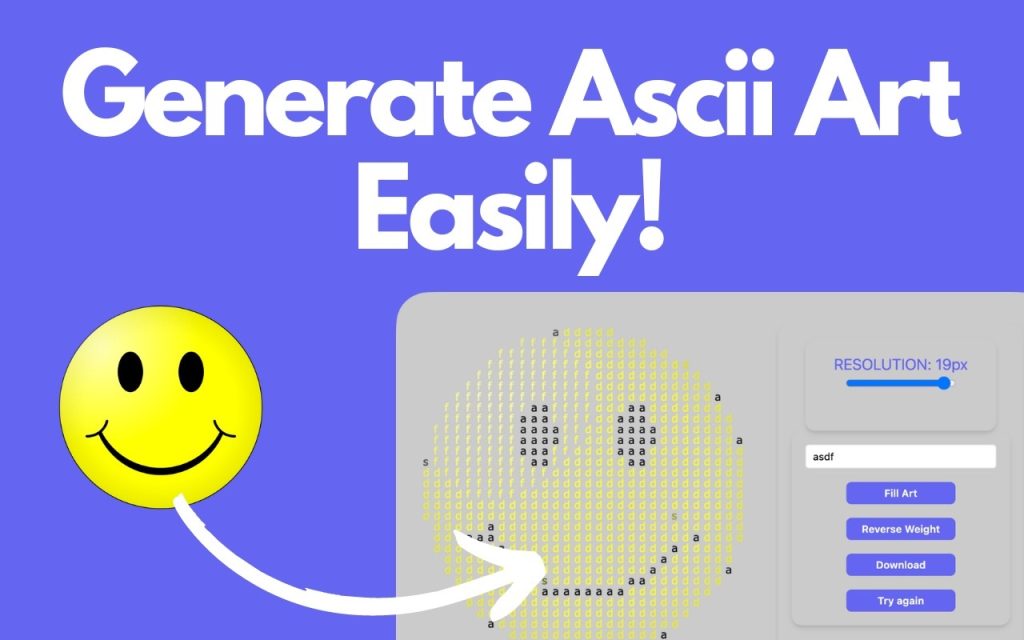Digital creativity has many forms, but ASCII art is one of the earliest examples of merging technology and artistic expression. Before advanced graphics and high-resolution images dominated the internet, text characters were used to design visuals that captured imagination. These designs, built entirely with letters, numbers, and symbols, became known as ASCII art.
The role of an ASCII is to make this process accessible to anyone. Instead of manually aligning hundreds of characters, modern tools automatically transform text, logos, or images into stylized ASCII visuals. They provide both hobbyists and professionals with an effortless way to explore an iconic form of digital expression.
Understanding It is not only about creating fun visuals, but also about appreciating a key element of internet history. These tools highlight how text can communicate beyond words, allowing creativity to thrive in coding, digital design, and personal expression.
ASCII Generator Meaning
Definition of ASCII
ASCII stands for American Standard Code for Information Interchange, a character encoding system developed in the 1960s. It assigns numerical values to letters, digits, punctuation, and symbols, enabling computers to process and display textual data consistently.
ASCII in Art and Design
ASCII art utilizes these characters in patterned ways to form pictures. Instead of using colors or pixels, ASCII art depends on character density, spacing, and arrangement. A generator automates this artistic process for efficiency and precision.
Purpose of ASCII Generators
An ASCII generator is a digital tool that converts plain text or images into ASCII-based visuals. By inputting words or uploading images, users can instantly generate creative designs. This makes ASCII generators valuable in personal expression, coding projects, and retro-inspired digital media.
How ASCII Generators Work
Input and Conversion
Users begin by typing text or uploading an image into the generator. Algorithms analyze the structure and convert elements into ASCII symbols, ensuring the visual retains shape and proportion.
Algorithms and Mapping
The tool maps pixels or letters to specific characters, considering brightness and density. Darker image areas might be represented with dense characters such as “#,” while lighter areas might use “.” or space.
Output Formats
Once generated, ASCII art can be copied as text, downloaded as images, or embedded into code. This flexibility makes ASCII generators accessible across multiple digital environments.
Popular Uses of ASCII Generators
Social Media Creativity
People use ASCII generators to create eye-catching usernames, captions, and posts. Designs stand out in crowded feeds because they break away from standard text formatting.
Coding and Development Projects
Developers add ASCII banners or text art to scripts, documentation, or terminals. It not only adds personality but also provides an instant brand or identity marker for projects.
Online Forums and Messaging
ASCII art became popular on forums, IRC chats, and emails. Generators allow modern users to revive this nostalgic form of communication, giving messages a unique twist.
Key applications include:
- Social media branding
- Developer code signatures
- Online memes and jokes
Advantages of Using ASCII Generators
Accessibility and Ease of Use
No special skills are required to create ASCII art with a generator. The interface typically involves simple copy-and-paste functionality, making it beginner-friendly.
Creativity and Uniqueness
ASCII art allows users to break away from generic fonts and emojis. Generated text or images express individuality while paying homage to digital culture.
Compatibility Across Platforms
ASCII visuals are text-based, meaning they can be displayed across platforms without compatibility issues. Unlike images, ASCII designs maintain clarity regardless of file type or device.
Benefits of ASCII generators:
- Fast conversion of images or text
- No design expertise required
- Works on multiple devices and apps
Limitations of ASCII Generators
Lack of Color Depth
ASCII art is limited to monochrome representation. Generators cannot capture the full vibrancy of colors, making the results more abstract than realistic.
Dependence on Formatting
Generated ASCII may appear distorted if pasted into platforms that use proportional fonts instead of monospaced ones. Correct display requires compatible environments.
Limited Detail in Complex Images
Highly detailed images often lose clarity when converted. Generators simplify visual elements, so results may not fully replicate original images.
Limitations include:
- Minimal color control
- Formatting inconsistencies
- Reduced detail accuracy
Future of ASCII Generators
Integration with AI
AI-powered ASCII generators are emerging, enabling smarter mapping of characters. They can balance detail retention with creative design, expanding the artistic scope.
Role in Digital Art Movements
ASCII art is experiencing a revival among digital artists. As minimalism and retro aesthetics gain popularity, ASCII generators provide an accessible creative tool.
Applications in Branding and Marketing
Companies may incorporate ASCII visuals in branding campaigns. Retro-style designs can capture nostalgia and attract digital-native audiences, blending tradition with innovation.
FAQs
What is an ASCII generator used for?
An ASCII generator is used to transform text or images into ASCII art for creative, nostalgic, or branding purposes.
Can ASCII art work on all platforms?
Yes, ASCII art works across most platforms, though monospaced fonts ensure the best display quality.
Are ASCII generators free to use?
Most ASCII generators are free online tools, though advanced features may be available in premium versions.
Can I convert photos into ASCII art?
Yes, photo-to-ASCII generators allow images to be uploaded and automatically converted into artistic text-based visuals.
Is ASCII art still popular today?
Yes, ASCII art remains popular for nostalgic expression, coding culture, and unique design elements in modern media.
How do ASCII generators differ from regular text fonts?
ASCII generators create visual patterns and designs using characters, while regular fonts simply change the style of letters without forming images.
Can ASCII art be printed?
Yes, ASCII art can be printed just like regular text. Monospaced fonts should be used to maintain alignment and clarity.
Do ASCII generators work offline?
Some ASCII generator software offers offline functionality, but most tools are browser-based and require an internet connection.
Is ASCII art the same as Unicode art?
No, ASCII art uses only basic ASCII characters, while Unicode art includes a broader range of symbols and emojis.
Can ASCII generators be used in coding projects?
Yes, developers often use to create headers, banners, or comments in source code for a personalized look.
Conclusion
ASCII generators showcase the creative potential of text, transforming simple words or images into memorable visuals. They remain relevant because they merge nostalgia with modern design, offering accessibility and uniqueness. Despite limitations in detail and color, ASCII art continues to inspire digital creators, coders, and hobbyists. Future developments may integrate AI to enhance precision, keeping ASCII generators a vibrant part of online culture. ASCII demonstrates that even the simplest elements of language can inspire boundless creativity.


